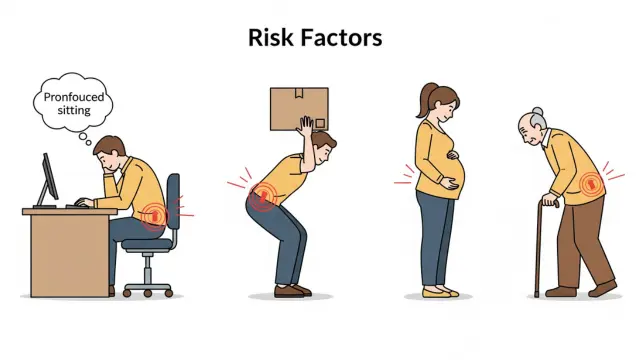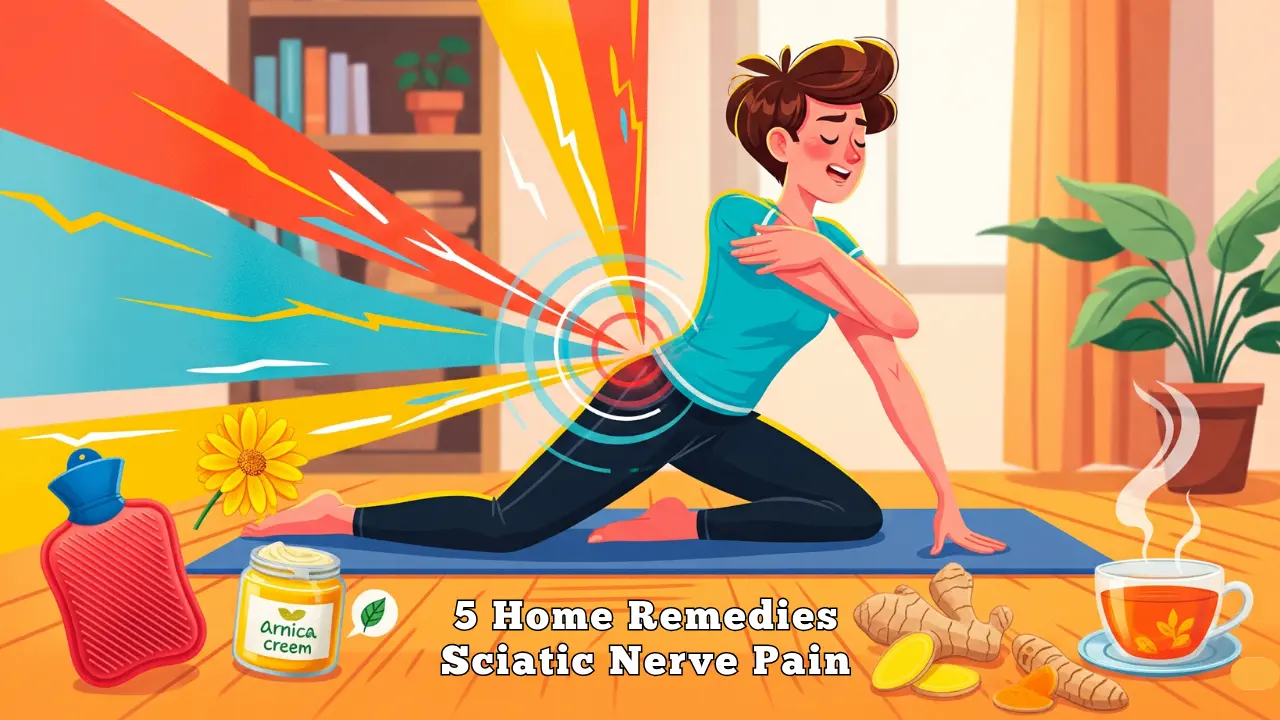Sciatic nerve pain, also known as sciatica, is one of the most common and misunderstood health issues. It affects millions of people worldwide, presenting as sharp pain that runs from the lower back down through the hips, legs, or even the feet. While doctors may prescribe medication or surgery in severe cases, most people first turn to safe, natural home remedies for relief.
In this guide, our HB Mag Health Research Team has scoured the research, expert advice, and real patient experiences to bring you the most effective, science-backed home remedies for sciatic nerve pain. We’ve looked at heat and cold therapy, gentle stretches, herbs, and lifestyle fixes.
Our aim is simple. To give you clear, easy-to-follow solutions that reduce pain, support healing, and improve daily comfort – no jargon or false promises.
What Is Sciatic Nerve Pain?
Sciatic nerve pain, often called sciatica, is not a disease itself but a symptom of an underlying problem. It happens when the sciatic nerve — the largest nerve in the body — becomes compressed, irritated, or inflamed.
The sciatic nerve starts in the lower spine, runs through the hips and buttocks, and travels down each leg. When something puts pressure on this nerve, it can cause pain that:
- Begins in the lower back or buttocks
- Shoots down the back of the thigh
- Sometimes reaches the calf or foot
Common Causes of Sciatica
- A herniated disc is pressing on the nerve
- Spinal stenosis (narrowing of the spinal canal)
- Degenerative disc disease
- Pregnancy, due to the extra pressure on the spine
- Muscle spasms in the buttocks (piriformis syndrome)
Key Symptoms
- Sharp or burning pain in the leg or lower back
- Tingling, numbness, or “pins and needles”
- Muscle weakness in the affected leg
- Pain that worsens with sitting, coughing, or bending
Expert Insight
Dr. Emily Warren, PT, DPT, a physical therapist specializing in sciatica treatment, emphasizes the importance of early intervention.
“Sciatica is often misunderstood. Most people think any leg pain is sciatica, but it’s usually a sign of nerve irritation from the spine or muscles around the hip. Early intervention with gentle movement, proper posture, and targeted stretches can prevent chronic pain and reduce reliance on medication.”
In most cases, sciatica improves with simple lifestyle changes and home remedies. Only severe or long-lasting pain usually requires medical treatment.
Sciatic Nerve Pain Risk Factors
Not everyone gets sciatica, but certain factors increase the chances of sciatic nerve irritation or compression. Knowing these risk factors can help in prevention and early treatment.

- 1. Age: People between 30 to 60 years old are most affected. Age-related changes like disc degeneration and bone spurs increase the risk.
- 2. Job: Jobs that require heavy lifting, twisting, or prolonged sitting put extra stress on the lower back. Drivers, office workers, and warehouse staff are more prone.
- 3. Sedentary Lifestyle: Sitting for long hours weakens the core muscles that support the spine. Poor posture or lack of physical activity can increase pressure on the sciatic nerve.
- 4. Excess Body Weight: Extra weight adds stress to the spine and can accelerate disc wear and tear. This can cause nerve compression.
- 5. Pregnancy: Hormonal changes loosen ligaments, while extra body weight and belly pressure can irritate the sciatic nerve.
- 6. Underlying Health Conditions: Diabetes can damage nerves and worsen symptoms. Conditions like osteoarthritis or spinal stenosis also increase risk.
- 7. Smoking: Smoking reduces blood supply to the spine, leading to faster disc degeneration. This can cause herniated discs and nerve pain.
Types of Sciatic Nerve Pain
Sciatica isn’t the same for everyone. The pain can be sharp, dull, burning, or even electric-like. Doctors categorize sciatic nerve pain into different types based on its cause, location, and symptom pattern.

- 1. Acute Sciatica: Acute Sciatica is a short-term pain that lasts up to 6 weeks. Caused by sudden injury, muscle strain, or a herniated disc. Symptoms include sharp lower back pain that radiates down one leg.
- 2. Chronic Sciatica: Chronic Sciatica is a type of pain that lasts more than 3 months. Linked to long-term conditions like spinal stenosis, arthritis, or recurring disc problems. Pain may fluctuate between mild and severe, but it never goes away fully.
- 3. Alternating Sciatica: This type of nerve pain switches from one leg to the other (not at the same time). Rare but often linked to sacroiliac joint issues.
- 4. Bilateral Sciatica: Pain affects both legs at the same time. Caused by severe spinal conditions like herniation in multiple discs or spinal stenosis. Needs immediate medical attention.
- 5. Neurogenic vs Referred Sciatica: Neurogenic Sciatica is a direct nerve compression due to a herniated disc, a bone spur, or spinal narrowing. On the other hand, Referred Sciatica is a pain that originates from muscles or joints but mimics sciatic symptoms.
Sciatic Nerve Pain Home Remedies
Living with sciatica is a pain, but the good news is that many people get relief with simple, natural remedies at home. These methods reduce inflammation, relax tight muscles, and ease the pressure on the nerve – without medication.
1. Cold and Heat
Cold and heat are the first line of defense against sciatic pain. Cold in the first couple of days numbs the sharp pain and reduces swelling. Once the inflammation settles, heat loosens stiff muscles and improves blood flow. Many people find alternating between the two works best – cold to calm the irritation and heat to soothe the tightness.
2. Gentle Stretching
Tight muscles in the lower back and hips make sciatica worse. Gentle stretching eases that tension and gives the nerve more space. Poses like the seated spinal twist or a simple hamstring stretch are great options. Just move slowly, never force the stretch, and listen to your body. Over time, these small daily stretches can make sitting, walking, and even sleeping so much more comfortable.
3. Low Impact Exercise
Rest is important during flare ups but too much inactivity can actually make sciatica worse. Light exercise like walking, swimming, or yoga keeps the spine flexible and strengthens the muscles that support it. These movements promote healing by improving circulation and preventing stiffness. Unlike high-impact workouts, which can jar the spine, low-impact activity keeps the pain under control while promoting long-term recovery.
4. Massage Therapy
Massage is another way to calm sciatic nerve pain. By working into the deep tissues of the back and glutes, massage releases muscle knots that may be pressing on the nerve. Even a short session can reduce stiffness and improve mobility. At home, a foam roller or massage ball can mimic some of these effects. Adding essential oils like peppermint or lavender can also enhance relaxation.
5. Improve Posture and Ergonomics
Many people with sciatica find their pain gets worse after hours of sitting. Slouching puts pressure on the lower back, which then irritates the sciatic nerve. Using a chair with lumbar support, keeping both feet on the ground, and standing up to stretch every 30 minutes can make a big difference. For desk workers, an adjustable chair and monitor at eye level help maintain spinal alignment.
Diet for Sciatica Nerve Pain Relief
What you eat can affect how your sciatic nerve feels. Some foods calm inflammation, others can make pain worse. Focus on nutrient-dense foods to support recovery and reduce flare-ups.
Anti-Inflammatory Foods
Eat these regularly to soothe irritated nerves:
- Fruits: Berries, cherries, oranges — antioxidants.
- Vegetables: Spinach, kale, broccoli — magnesium and vitamins for muscle and nerve health.
- Healthy fats: Oily fish (salmon, sardines), olive oil, nuts and seeds — natural anti-inflammatories.
Foods to Limit
Some foods can make pain and stiffness worse:
- Processed snacks, fried foods, and sugary drinks
- Excess caffeine and alcohol
Hydration matters too. Water keeps your discs cushioned and reduces tightness. Herbal teas like turmeric, ginger, or green tea can give an extra anti-inflammatory boost.
Some people may benefit from Nerve pain supplements like magnesium, B-vitamins, or vitamin D to support nerve and muscle health — always under medical guidance.
A sciatica diet isn’t about restriction. It’s about choosing foods that help your body heal and avoiding triggers that make pain flare.
Home Exercise & Stretching for Sciatic Nerve Pain
Being active is one of the best ways to get rid of sciatic nerve pain. While rest is important during severe flare-ups, prolonged inactivity can make stiffness worse and slow down recovery. Gentle exercises and stretches help loosen tight muscles, reduce nerve pressure, and improve blood flow.
Gentle Stretches to Try at Home
These moves target the lower back, hip, and hamstrings — common areas that cause sciatica:
- Piriformis Stretch: Lie on your back, cross one ankle over the opposite knee, and gently pull the thigh towards your chest. Hold for 20-30 seconds.
- Knee to Chest Stretch: Lie on your back and pull one knee at a time towards your chest. Repeat 3-5 times per leg.
- Seated Hamstring Stretch: Sit tall, extend one leg forward, and hinge at the hips to feel the stretch.
Low Impact Exercises
In addition to stretching, light movement can help with recovery:
- Walking: Short walks throughout the day help keep you mobile without jarring the spine.
- Cat-Cow Pose: On hands and knees, alternate arching and rounding the back to mobilize the spine.
- Pelvic Tilts: Lie flat, engage your core, press your lower back into the floor, hold briefly, and release.
Tips for Safety and Effectiveness:
- Always move slowly and don’t bounce during stretches.
- Only stretch to a mild, comfortable tension — never into pain.
- Start with 5-10 reps per exercise and gradually increase as you get more comfortable.
- Consistency is more important than intensity; daily practice is better than sporadic sessions.
Try these stretches and exercises, and you’ll reduce sciatic nerve pressure, relieve pain, and prevent future flare-ups. Combine them with posture adjustments and an anti-inflammatory diet for better results.
Sleep Positions & Ergonomics for Sciatica Relief
How you sleep and sit can make a big difference in sciatic nerve pain. Poor alignment can put pressure on the lower back and worsen symptoms, while good alignment helps healing and reduces discomfort.
Best Sleeping Positions
Some positions help relieve nerve tension and prevent morning stiffness:
- Side Sleeping with Pillow Between Knees: Keeps the spine neutral and reduces pressure on the lower back.
- Back Sleeping with Pillow Under Knees: Flattens the lumbar curve slightly and eases sciatic tension.
- Avoid Stomach Sleeping: This can strain the lower back and worsen nerve compression.
Ergonomics for Daily Life
Besides sleep, posture during the day matters too:
- Use a chair with lumbar support and feet flat on the floor.
- Stand up and stretch or walk every 30–45 minutes if you sit for long periods.
- Keep your computer monitor at eye level to avoid slouching.
- When lifting objects, bend at the knees and don’t twist your spine.
Small changes in how you sit, stand, and sleep can reduce flare-ups over time. Combine with stretches, exercise and diet, and good ergonomics will help you recover faster and maintain nerve health.
What To Avoid During a Sciatic Flare (And What To Resume Later)
Sciatica flare-ups can be brutal, and knowing what to avoid helps stop the pain from getting worse. And knowing what you can resume once the symptoms subside ensures a safer, faster recovery.
What to Avoid During a Flare
In the first few days of sharp pain or numbness, reduce stress on the sciatic nerve:
- High-impact exercise: Running, jumping, or heavy lifting will make it worse.
- Long sitting: Sitting for too long will put pressure on your lower back and butt.
- Twisting movements: Sudden twists or bending will make it worse.
- Sleeping on your stomach: Strains your lower back and spine.
What You Can Resume Later
Once the acute pain starts to subside, gradually introduce movement and activity:
- Gentle walking: Gets the blood flowing and supports healing.
- Stretching and yoga: Focus on hamstrings, hips, and lower back.
- Strength training: Core and glute exercises will prevent future flare-ups.
- Normal daily activities: Resume with caution and good posture.
Key Tip: Listen to your body. Sharp pain is a warning to stop; mild discomfort is often safe and part of the recovery process. Tracking what movements trigger flare-ups will help prevent future episodes.
Do Supplements Help Sciatic Nerve Pain?
Many people with sciatica ask if supplements can actually reduce nerve pain or support recovery. While no pill can replace proper stretching, posture, and anti-inflammatory care, some natural supplements may reduce inflammation, support nerve health, and ease discomfort.
Top Supplements for Sciatica
- Nerve Calm: Formulated to support nerve function and reduce discomfort. Users report tingling and numbness improvements over time.
- Arialief: For nerve regeneration and overall nerve health. Contains ingredients to calm nerve irritation.
- Magnesium: Relaxes tight muscles in the lower back and glutes.
- B-Vitamins (B1, B6, B12): Support healthy nerve function and may reduce neuropathic pain.
- Turmeric / Curcumin: Natural anti-inflammatory to ease sciatic pain flare-ups.
- Omega-3 Fatty Acids: Found in fish oil, they reduce inflammation and support spinal health.
How Supplements Fit Into a Recovery Plan
Supplements work best as part of a whole approach:
- Combine with stretching and low-impact exercise to relieve nerve pressure.
- Support an anti-inflammatory diet that fuels healing.
- Pair with good sleep, ergonomics, and posture to prevent recurring flare-ups.
Tip from our HB Mag Health Research Team: Supplements are not instant painkillers. They support the body over time and should be used with lifestyle changes. Always consult a healthcare professional before starting a new supplement, especially if you take medications or have chronic conditions.
Final Verdict
Sciatic nerve pain is annoying, but most cases can be fixed with simple lifestyle changes, home remedies, and targeted exercises. Early intervention is key. Stretching, low-impact movement, good posture, and an anti-inflammatory diet all work together to reduce nerve pressure and prevent chronic pain.
Supplements like Nerve Calm and Arialief may help with nerve health, and other natural options like magnesium, B-vitamins, and omega-3s can help with discomfort over time. These are best used as part of a holistic recovery plan, not as standalone fixes.
In short, sciatica doesn’t have to control your life. With the right combination of movement, diet, posture, and natural support, most people get relief at home.
Frequently Asked Questions
How to stop sciatica pain now?
Immediate relief comes from gentle stretches, cold or heat, and short walks. No sudden movements or heavy lifting. Over-the-counter pain relievers like acetaminophen or NSAIDs help symptoms, not the cause.
How to cure sciatica at home?
There’s no one “cure,” but consistent stretching, posture correction, exercises, and an anti-inflammatory diet can reduce flare-ups over time. Adding Nerve Calm or Arialief can support nerve health.
Sciatica exercises / Sciatica pain exercises
Low-impact exercises relieve nerve pressure:
- Piriformis stretch
- Knee-to-chest stretch
- Pelvic tilts
- Walking or swimming to keep muscles flexible
Consistency is key — even 10-15 minutes a day makes a difference.
Say goodbye to sciatic nerve pain in 10 minutes with this natural method
No method is guaranteed in 10 minutes, but targeted stretches, heat, and deep breathing often give quick relief. Think of it as a “reset” for tight muscles and inflamed nerves.
How to relieve sciatica pain?
- Cold pack for 15-20 minutes if pain is acute.
- Heat after swelling goes down.
- Gentle stretching or short, slow walks to loosen tight muscles.
Best pain relief for sciatica / Strongest painkiller for sciatica
- Over-the-counter: NSAIDs like ibuprofen.
- Prescription options for severe cases — always consult a doctor.
- Natural support through Nerve Calm, Arialief, magnesium, and B-vitamins can help nerve function and reduce discomfort over time.
We’re a small team of health writers, researchers, and wellness reviewers behind Healthy Beginnings Magazine. We spend our days digging into supplements, fact-checking claims, and testing what actually works—so you don’t have to. Our goal is simple: give you clear, honest, and useful information to help you make better health choices without all the hype.



Recent Posts